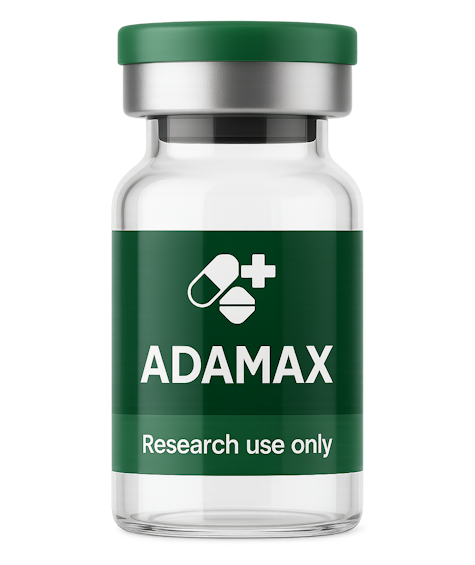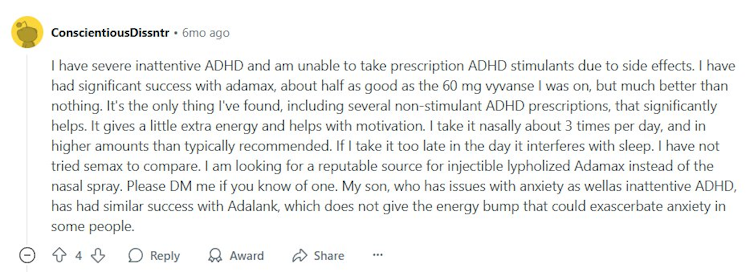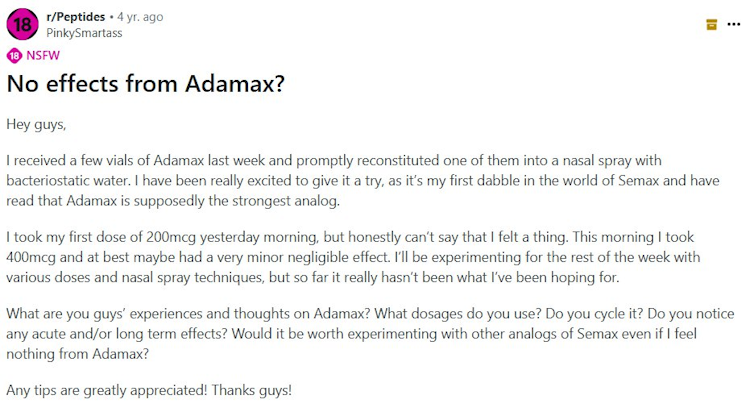Adamax Peptide: A Comprehensive Guide
Adamax is a specialized bioactive peptide studied for its potential effects on the central nervous system and cognitive enhancement. As a next-generation nootropic peptide, it’s designed to support brain health, improve cognition, and provide potential neuroprotective effects. Developed through decades of research in molecular genetics and neuropharmacology, this peptide offers insights into how targeted compounds may contribute to neurological well-being.
This article explores what Adamax (and how it compares to Semax) is, how it works, associated benefits and side effects, and the mechanisms involved—drawing from human and animal models and references from major research institutes.
🧠 Big Picture Summary
- Discover Adamax Peptide, a cutting-edge nootropic peptide researched for cognitive enhancement, focus, and neurological recovery. ⚡
- Learn how Adamax compares to Semax, and why it’s considered a next-generation neuropeptide with unique BDNF-boosting properties. 🔬
- Understand how this compound crosses the blood-brain barrier to influence neurotransmitters, gene expression, and synaptic plasticity. 🧩
- Explore its potential in stroke recovery, stress regulation, and neuroprotection, based on early research and institute reports. 📚
- Get insights from real user experiences, forum discussions, and lab-based research on dosing, delivery, and effectiveness. 💭
Where Did This Peptide Come From?

Where Did This Peptide Come From?
Adamax peptide has its roots in advanced research programs conducted in the late 20th and early 21st centuries. Researchers set out to create novel nootropic peptides able to cross the blood-brain barrier effectively—a key requirement for CNS-active compounds.
Drawing inspiration from compounds like Semax, which showed promise in neurological settings, scientists designed Adamax with peptide fragments such as Met Glu His Phe, Glu His Phe Pro, Pro Gly, Gly Pro, and Phe Pro Gly—amino acid sequences known to influence neuronal signaling pathways.
The program built on earlier discoveries around adrenocorticotropic hormone (ACTH) and its derivatives. By combining these sequences with modern neuroactive design, Adamax was formulated to amplify desired effects compared to prior generations.
Understanding Its Structure and Components
This peptide is constructed from specific fragments with roles in neurological function, including effects on brain-derived neurotrophic factor (BDNF):
- Met Glu His Phe – involved in neurotransmitter interactions and brain signaling.
- Glu His Phe Pro – supports synaptic plasticity and learning.
- Pro Gly and Gly Pro – contribute to structural stability and cellular expression.
- Phe Pro Gly – associated with improved cognition and neuronal resilience.
Together, these fragments yield a compound small enough to traverse the BBB—crucial for acting directly on brain activity.
Mechanism of Action
Adamax appears to work through several intertwined processes impacting neurotransmitters, signaling pathways, and genetic expression. A primary focus is boosting BDNF, a protein essential for neuron survival, growth, and maintenance. Increased BDNF may support stronger synaptic connections tied to learning, cognition, and memory.
Another mechanism involves interactions with ACTH fragments and the HPA axis (hypothalamic-pituitary-adrenal), which helps regulate stress hormones and may reduce inflammation associated with neurological conditions.
Reviews and Testimonials From Actual Users
So finding real reviews and testimonials from people that have used Adamax peptide is a little challenging. There are a few Reddit threads that discuss the peptide, most notably in the Biohackers and Nootropics subreddits.
Most commentors, specifically the ones that have used the nasal spray version, have reported immediate effects. This isn’t surprising, given peptides that come in nasal spray format almost always work way faster than traditional methods of administration (i.e. capsules, tablets, or sublingual).
The most thorough discussions seem to be happening on the Nootropics subreddit. One commentor that goes by the username ‘ConscientiousDessntr’ stated that they had great success with this peptide, likening it to being about half as effective as their Vyvanse prescription.

The only downside they mentioned was that it causes insomnia if taken too late in the day.
Another commentor noted that they took a standard dose of 200 mcg, and felt virtually no effect:

That same user went on to state that they tried upping the dosage to 400 mcg the next day, and basically had the same response (i.e. no effects).
Most of the other testimonials seem to note that Adamax essentially feels like a more stimulating version of Semax peptide. I couldn’t confirm this on my end, as I haven’t had a chance to try out Semax myself.
That said, I’ve heard some really good stuff about it, so it’s on my list of nootropics to try.
My Personal Results
So like a lot of others probably reading this, I suffer from my own bouts of ADHD. I haven’t been directly diagnosed for the condition, but it doesn’t take a scientist of psychiatrist to determine whether or not I have problems focusing or paying attention to stuff.
I’ve tried everything under the sun when it comes to all natural ADHD alternatives:
- Caffeine with L-Theanine
- Ginkgo Biloba
- Omega-3’s
- Saffron
And a whole host of otc supplements that claim they’re more effective then prescription ADHD meds. Of course, none of them even come close to the real thing, but I did note some subtle differences.
Once I heard about Adamax, I told myself I needed to try it. I picked up an off-label brand in a supplement store that is near me that actually carries the stuff, and waited a few days before taking it.
Normally I don’t like taking nasal sprays; I have really bad allergies from time to time, and blow my nose for what feels like 150 times per day. Obviously this doesn’t bode well if you’re tying to take a substance like this one in nasal spray format…you’ll just end up blowing half of the stuff out of your nose.
I definitely noticed the effects probably within 5 – 10 minutes of taking the first spray.
It wasn’t some massive difference, but I felt as though I had more motivation to get general stuff done. Nothing too complicated, but more of the mundane type of work that most of us procrastinate on.
I took a 2nd dose about 4 hours later, and that’s when it really seemed to work best. This was around 1 pm in the afternoon, and I just started hammering out work like it was nobody’s business.
Like many of the other reviews I read, I did have a bit of a hard time trying to fall asleep that night, but not too bad.
All in all, I can say with 95% confidence that this stuff really does work.
4 Potential Benefits of This Peptide
1. Cognitive Enhancement
One of the most studied benefits of this peptide is its ability to support cognitive enhancement. By boosting BDNF and improving neurons’ synaptic plasticity, the peptide helps with:
- Learning and memory retention
- Increased mental clarity and focus
- Better problem-solving skills and cognition
Several studies have reported that humans receiving this peptide under controlled research conditions experienced measurable improvements in mental performance.
2. Neuroprotective Effects
This peptide has shown promising neuroprotective effects, especially in stroke recovery. In clinical studies, patients treated with Adamax peptide shortly after a stroke had better neurological outcomes compared to control groups. These results suggest the peptide may reduce oxidative stress and help repair damaged neurons.
3. Support for the Central Nervous System
The peptide’s unique structure allows it to penetrate the blood brain barrier, enabling direct action on the central nervous system. This targeted approach may contribute to better outcomes in various neurological diseases, including:
- Post-stroke rehabilitation
- Degenerative conditions like Alzheimer’s or Parkinson’s
- General age-related cognitive decline
4. Potential for Stress Regulation
By influencing ACTH pathways, this peptide may help balance stress hormone levels, improving mood stability and emotional resilience. This function aligns with its origins in ACTH fragment research, where stress adaptation was a primary area of study.
Adamax vs. Semax: A Comparison
Both Adamax and Semax belong to the same family of nootropic peptides, and they share similar mechanisms, especially regarding BDNF stimulation and cognitive enhancement. However, there are notable differences:
| Feature | Adamax | Semax |
|---|---|---|
| Structure | Incorporates Met Glu His Phe, Glu His Phe Pro, Pro Gly, Gly Pro, Phe Pro Gly | Primarily ACTH fragment based |
| Primary Use | Broader applications in cognitive and neuroprotective research | Commonly used for stroke recovery |
| BDNF Influence | Amplified compared to older peptides | Moderate |
| Commercial Availability | Limited sale through specialized sites | More widely available |
The comparison highlights this peptide’s broader potential but also its limited accessibility due to its research status.
Scientific Research and Evidence
Multiple studies and sciences programs have been performed to evaluate Adamax peptide’s safety and effectiveness. Much of the foundational work comes from the Russian Academy and affiliated institute laboratories, where researchers focused on both animal and human models.
Key findings include:
- Animal studies demonstrated enhanced cognition and learning abilities, showing promising effects in neuroplasticity.
- Human studies confirmed the peptide’s ability to improve post-stroke recovery compared to placebo groups.
- Cellular research revealed increased BDNF expression, supporting its role in neurological health.
This body of evidence suggests that this peptide holds significant potential, though more research is needed to fully understand long-term implications.
How To Use This Peptide
This peptide is generally used in controlled laboratory settings rather than for commercial or recreational purposes. The use of Adamax peptide typically involves:
- Administration Methods
- Intranasal delivery for direct access to the brain through the olfactory system
- Injectable forms for systemic distribution
- Dosage and Timing
Dosages are determined strictly under experimental protocols, with careful monitoring of levels and time intervals to ensure optimal effects. - Safety Considerations
- All handling follows strict laboratory guidelines.
- Humans participating in research must meet ethical and regulatory requirements.
- Peptide purity and preparation are critical, as contaminants can alter results.
Availability and Sales Considerations
Due to its status as a research compound, Adamax peptide is not typically available for general sale. It is mainly distributed through specialized sites that provide products for scientific investigation only. These sites often require documentation of institutional affiliation or professional credentials before fulfilling an order.
When seeking products, it is important to:
- Verify the authenticity of the site offering the peptide.
- Ensure the supplier has proper certifications and quality control procedures.
- Avoid unauthorized sale channels that may use misleading marketing tactics.
Legitimate products will clearly state that they are based on research purposes only and are not intended for direct consumption or therapeutic use outside of controlled studies.
Side Effects and Safety Profile
While this peptide shows promise, it is not without potential side effects. Reported side effects in studies and research logs include:
- Mild headaches or dizziness
- Temporary changes in mood or cognition
- Nasal irritation with intranasal delivery
- Rare allergic reactions to peptide fragments
Long-term safety remains under investigation. Researchers continue to investigate its potential impact on systemic health and neurological stability over time.
Key Scientific Concepts Related To This Peptide
Brain Derived Neurotrophic Factor (BDNF)
BDNF plays a central role in Adamax peptide’s action, influencing synaptic growth and neuroplasticity. Higher BDNF levels are associated with improved learning and recovery after neurological damage, such as a stroke.
Blood Brain Barrier
The blood brain barrier is critical to understand because only compounds capable of crossing it can directly affect the brain. This peptide’s structure was designed specifically to penetrate this barrier efficiently.
Molecular Genetics and Regulation
By targeting specific pathways in molecular genetics, Adamax peptide may alter gene expression related to neurotransmitter synthesis and stress regulation, providing a deeper understanding of how peptides can be tailored for neurological health.
Ongoing Research and Future Directions
The future of Adamax peptide lies in continued research across multiple scientific categories. Key areas of exploration include:
- Broader studies on post-stroke rehabilitation
- Investigating its impact on degenerative neurological diseases
- Evaluating long-term safety in humans
- Refining peptide formulations for more efficient use
These efforts will help clarify this peptide’s potential and determine whether it can transition from laboratory research to practical clinical applications.
Conclusion
This peptide represents a significant advancement in the field of nootropic peptides, particularly in its potential for gene expression and neurological health. Through carefully designed amino acid sequences like Met Glu His Phe, Glu His Phe Pro, Pro Gly, Gly Pro, and Phe Pro Gly, it has demonstrated an ability to cross the blood brain barrier, influence BDNF levels, and support cognitive enhancement.
While still primarily limited to research, the growing body of evidence from studies and researchers worldwide underscores its potential, providing valuable content for further exploration. Whether improving learning, aiding stroke recovery, or providing general neuroprotection, Adamax peptide is a compound worth watching as science continues to investigate its effects and applications.
For those interested in learning more, reputable sites and academic institutes provide published content, references, and study logs that detail current findings; interested individuals can also reach out via email for inquiries. As with all experimental compounds, responsible handling and ethical use remain paramount while awaiting further results.
